If you are currently spending too much to reach you savings or debt reduction goal, you have two options: 1) increase your income; and/or (2) cut your expenses.
Increasing Your Income
Increasing your income may or may not be a practical solution given the nature of your job and the employment opportunities in your area. The ways to do it are obvious. You could seek a raise or better paying job; work extra hours (if they are available and you are paid by the hour); or try to get a second job. A stay-at-home spouse/partner could return to work. These choices may be undesirable as they can have a negative impact on your health and family life.
Here’s one idea that doesn’t involve a change in your employment and could give you more money in your paycheck. If you are getting a substantial tax refund each year, you could consider having less deducted from your paycheck. You won’t get the big tax refund, but spreading the income out over the year may be more beneficial to your budget. You may be more likely to save the extra money that comes every payday, than a big sum that comes once a year.
Cutting Your Expenses
These are the essential expenses your budget should provide for in order of importance:
• Housing and food.
• Utilities.
• A vehicle where public transportation is not available.
• Insurance (auto, medical, life if you have dependants, homeowners).
• Child support, alimony.
• Taxes.
• Student loans and tuition.
• Savings.
• Entertainment.
Consider trimming the following expenses to get to your goal. Some you may decide to eliminate entirely; others you may simply decide to cut back on.
• Donations.
• Gifts.
• Eating out.
• Take-out food, coffee, tea, and specialty drinks.
• Premium cable channels.
• Travel and vacations.
• Club memberships.
• Gym memberships.
• Buying books, magazines, and newspapers.
• Manicures/pedicures/hair appointments.
• Spa treatments.
• Housekeeping and gardening services.
• Movies at the theater.
• Alcohol and cigarette purchases.


